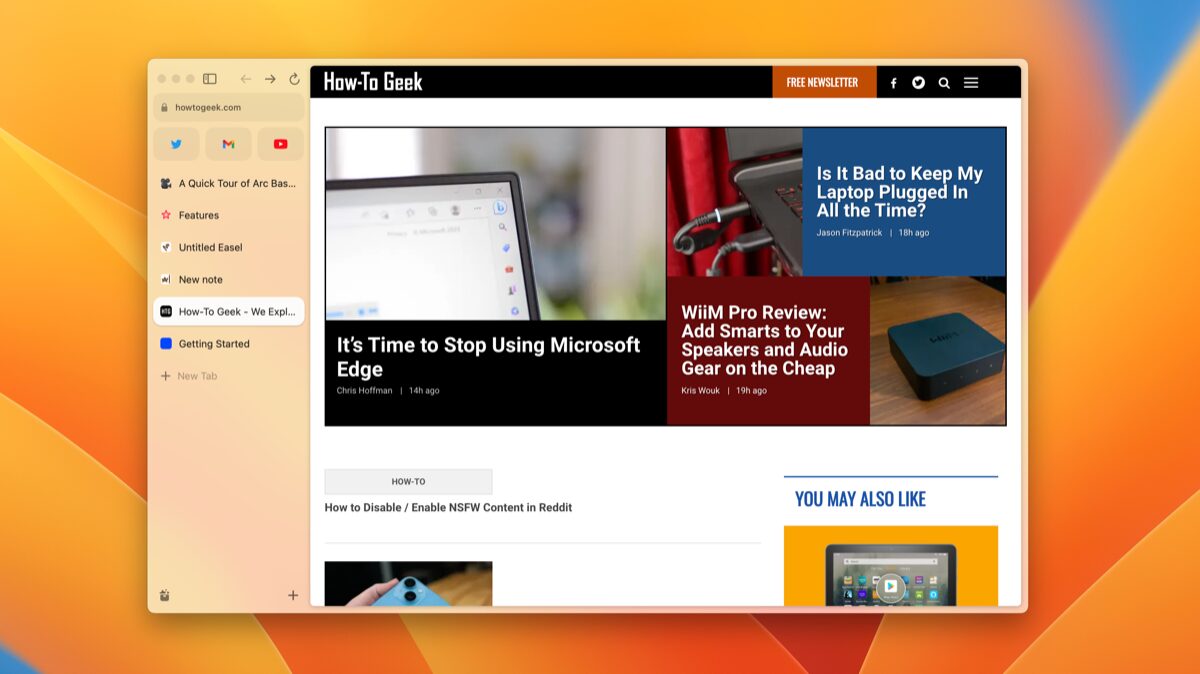The Motorola Razr Delivers Nostalgia But Leaves Me Wanting More
Android
Key Takeaways
- The Motorola Razr (2024) offers innovative features like an improved external display and upgraded cameras.
- The Razr’s design feels like a work in progress compared to the Razr+, with underpowered specs.
- Selfie-takers will appreciate the external screen’s high-resolution cameras, but the image quality may underwhelm some users.
The Motorola Razr (2024) flip phone has an interesting form factor and great features. It will be a hit with selfie-takers who want the highest-resolution images. Still, it feels like a phone that’s at least a generation away from fulfilling the promise of flip phones.
I’m a fan of tablet-style flip phones, but even after using this new Razr, I’m still not sold on the clamshell design. During my testing, I found myself wishing I was using a traditional slab-style phone for some tasks. I enjoyed the functionality of this flip phone, but the user experience was either fantastic or cumbersome, depending on what task I was doing.
That said, the phone succeeds admirably at its goals. The Razr delivers on the promise of a foldable phone and offers a user experience impossible with either a standard phone or a tablet-style foldable.
The Razr fits nicely in my pocket, and the external screen increases my creativity compared to my iPhone. I might not buy a clamshell folding phone, but using it was generally a pleasure, albeit with a few caveats.


Motorola Razr (2024)
The Motorola Razr gives you new ways to interact, capture, and create. Featuring a larger external display, an upgraded folding mechanism, and powerful cameras, you can do it all without flipping the phone open.
- Very good external screen increases usefulness
- Fits even small pockets
- Crease on display barely visible
- Very good battery life
- Only 256GB of storage available
- External display interface needs more work
- Image quaity below expectations
Price and Availability
Motorola’s Razr is the lower-end of its two newest flip phones introduced this year. It is a tempting and intriguing piece of hardware, but it falls short of the more powerful Razr+.
The Motorola Razr (2024), technically called the Motorola Razr 50, sells for $699–a far cry from the $999 Razr+. The “low” price of the Razr explains some of the shortcomings I felt it suffered from. This flip phone ships with 256GB of storage and 8GB of RAM, a 3.6-inch external display. Oddly, it uses the underpowered MediaTek Dimensity 7300x processor chip.
The Razr+ has a significantly faster Snapdragon 8s Gen 3 processor, 12GB of RAM, and 256GB of storage, which explains why we found the Razr+ such a joy to use.
A Bit of Nostalgia, a Bit of Tomorrow
As an early adopter of cell phones, I owned a Razr v3 in 2004. It was a marvel of engineering and design.
There were two primary phone styles at the time: ultra-small boxy phones about the size of a Tic Tac case, often adorned with keyboards, and large (for the time) screens. Blackberry and Palm, Inc. devices were the most notable of this era.
The Razr v3 walked a fine line between the two. Its folding shell allowed it to be smaller than a clumsy Blackberry but still allowed for functionality when closed. It was elegant, durable, and immensely popular.
Today’s Razr is cut from the same cloth but isn’t the finely tailored Razr of yesteryear.
Awkward Design Often More Complex Than Necessary
In some ways, the Razr is a solution in search of a problem. I enjoyed the added functionality of the external display, but occasionally, the design was more limiting than helpful.
For instance, while testing the cameras on the Razr, I took it to my village’s Halloween parade. Due to the pokey speeds of the children, there are often gaps of several minutes between participants.
I couldn’t get into a good flow with the Razr. Putting it away in my pocket was fine, though flipping it closed required an extra step compared to the iPhone.
With my iPhone, I would have slid it into my back pocket. When something interesting passed, with one smooth motion, I could have removed the phone, launched the camera, and captured photos, all using only one hand.
Taking the Razr out to shoot a photo required a cumbersome juggling act. There is no easy way to open the phone with one hand, which is a problem if you’re holding something else.
I finally devised a system of prying it open by wedging the tip of my thumb between the two halves and then pushing the screen above the hinge to open it. I constantly worried I’d drop the phone when prying it open with my thumb.
The useability of the phone could be significantly increased if it had a small lip on the edge of the clamshell a thumb could use for leverage.
Hand Gestures Set the Razr Apart From Competitors
On the other hand (pardon the pun), Motorola’s gestures show how much is accomplished with good engineering.
The Razr can launch the camera when folded or opened simply by twisting the wrist twice as if you were trying to open a door with a slippery handle. It’s a motion I’m familiar with from the winding lever on a film camera.
Touching the screen with three fingers takes a screenshot, and it is much easier than pressing a combination of buttons.
Making a chopping motion toggles the flashlight on and off, and dragging from the edge brings up a menu of apps. Placing it face down silences the phone, and picking it up while ringing silences it, too.
The more gestures, the better.
I Love the Internal Screen and Size, but the Fold Inside May Bother Some
Motorola uses the same main display screen on the 2024 Razr+ and the 2024 Razr. The display is a 6.9-inch FHD+ pOLED display with a 2640 x 1080 resolution, which is 413ppi.
It’s a great screen with especially dark blacks and vivid colors. As with our review of the Razr+, I found the 6.9″ screen spacious but occasionally too big. The height of the display makes it hard to reach parts of the screen with one hand, which is the same reason I’ve never purchased the iPhone Max.
[Read more about the Razr+ on How-To Geek](https://www.howtogeek.com/motorola-razr-plus-2024-review/)Two-handed operation feels great, and I appreciate the aspect ratio when watching movies on the Razr.
I found the fold to be either annoyingly visible or not visible at all. The difference seemed to be the direction of ambient light and the colors being displayed.
The fold is also noticeable when running a finger across the screen. There’s a tangible dip across the screen that, unfortunately, is directly in the middle of the display.
This is the curse of foldable devices. While it’s possible to minimize the distraction of a fold, it’s not technologically possible to hide the fold completely. If you want a folding device’s functionality, you’ll get a crease in your screen.
The effect is similar to Apple’s Dynamic Island, the pill-shaped space at the top of the iPhone screen that houses the cameras. If the blank space catches my eye, I can’t un-see it.
Motorola also warns against removing the “screen protector.” There’s a warning sticker on the phone and in the packaging, and the phone also warns against removing it during device setup.
The screen protector Motorola is warning about is the screen itself. There is a film layer over the main display, presumably to eliminate a depression on the screen where the fold is. Based on the number of warnings, removing that would probably cause the phone to fall apart.
The External Screen and the Promise of This Folding Phone
The Razr’s 3.6-inch screen isn’t as sharp or vibrant as the 4-inch screen on the Razr+, one of the concessions to make the Razr more “affordable.”
Without directly comparing it to a Razr+, these shortcomings aren’t noticeable. The screen is bright enough to see in direct sun, and there is barely any screen lag.
I found the external screen more useful than anticipated but slightly less fleshed out than I expected. Not all apps run on the external display, and there can be glitches with those that do.
Google Photos works well on Razr’s external screen, though viewing photos and videos on the small display can be challenging. Squinting at thumbnail-sized videos is not the same as looking at a video on a full-sized display.
Other programs can be finicky. Launching Gmail for the first time brought up a display that said, “Chat and spaces are now in Gmail.” A dialog box prompted me to relaunch Gmail. Clicking the relaunch button results in the dialog box popping up again.
There’s a “not now” button in the dialog box, but it’s cut off on the external display. I had to flip the phone open to dismiss this notification on the main screen. These little quirks are common with the Razr.
Most other tasks work as expected. After unlocking, you can slide across the external display to move through lists of apps, widgets, calendars, and weather. Compatible apps are shown and can be launched with a single tap. Not every app is compatible, though, so only some tasks can be carried out on the external display.
I also found some user interface elements confusing. For instance, there is a “camcorder” mode that enables video shooting while the phone is folded in a V. The idea is to hold the display like you’d hold an old-school camcorder and use the screen to compose the shot.
Using a camera like this is less comfortable than recording video on the unfolded phone.
External Screen Selfies Is Why This Camera Exists
The external screen is a dream come true for selfie shooters. The external display houses the phone’s two camera lenses, so the high-resolution cameras are pointed at the selfie-taker (Selfier?) while the Razr is folded.
Taking high-quality photographic and video selfies with the phone folded closed feels like a revelation. This is clearly why this phone exists and the biggest reason to buy it.
The external display can also show a live preview of photos or videos during capture when the phone is open. When subjects can see what they look like before their photo is taken, they’re more likely to loosen up for the photo.
Promising Camera, Disappointing Results
I found the Razr’s images surprisingly lackluster. The phone skews heavily toward oversaturation. Fall flowers with deep red petals were rendered clown-nose red. Skin tones wash out easily in bright light, and the cameras tend to overexpose.
Night photography is lacking compared to shots I take with my iPhone, which I find surprising. Android has powerful computational photography prowess, but images taken in low light with the Razr are mostly disappointing.
The higher a camera’s resolution, the worse it performs in low light (all else being equal). The bigger a pixel on a camera sensor, the more light it can gather. As you add more pixels, the size of each pixel gets smaller, and the noise gets proportionally worse.
For a sensor this size, the 50MP resolution requires very small pixels. Computational photography addresses this by taking multiple photos and stacking them together to bring out the best in a shot. I suspect the lower-power processor is to blame for the lackluster low-light images.
Night Vision mode was hit-or-miss, mostly miss. Previews were often grainy and hard to see, and the results weren’t great. The low-power processor is likely to blame for my night photography and videography issues. We had much better results in our tests of the Razr+ than with the Razr.
Battery Life Is Good Enough for Everyday Use
After the bandwidth-intensive process of setting up the phone and the battery drain that goes with it, I found the battery life on par with most Android phones.
I spent a full day testing the phone’s handling of common work apps and then left it unplugged on my desk. The Razr was in standby mode, but the Wi-Fi was on, performing background tasks.
After several days of using it as a paperweight, the phone had 25% battery power. There was still enough juice for me to spend most of the day shooting photos and videos.
Should You Buy the Motorola Razr (2024)?
The criteria for determining if the 2024 Motorola Razr is right for you is simple. If you want a clamshell flip phone for its selfie prowess and easy app access, the Razr is a good choice. If you want the best performance, the Razr+ is the phone for you, but if that $999 price tag is hard to swallow, the $699 Razr is still an excellent choice.


Motorola Razr (2024)
The Motorola Razr gives you new ways to interact, capture, and create. Featuring a larger external display, an upgraded folding mechanism, and powerful cameras, you can do it all without flipping the phone open.























